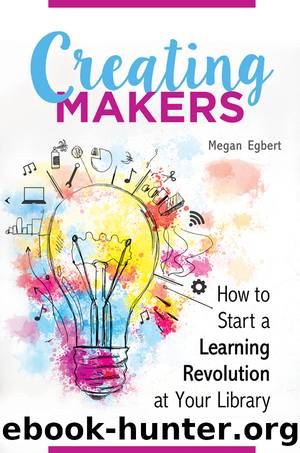Creating Makers by Megan Egbert

Author:Megan Egbert
Language: eng
Format: epub
Publisher: ABC-CLIO
Here are some examples of stealth maker programs that have worked well in our library:
Lego Braille: Set out Lego baseplates and bricks. Provide resources that participants could use to learn about braille (websites, books, pamphlets). Encourage participants to leave a message in Legos. The next participant should decode it, log it somewhere (so you can track stats), and then write a new message. Thematic tie-ins could be books or resources about codes, code breaking, visual impairment, etc. Offer extension activities for once they are done around those themes. (Write a message in morse code; then create your own code using these supplies and see if someone can decipher it.)
Building Challenges: Building challenges can be a really fun way to do stealth programs, but you have to be careful how you construct them so actual making takes place. For example, if you put out straws, balloons, cardboard wheels, and a sign that says âCan you make a car that goes from this spot to this spot?â what do you think participants will make? You have overconstructed their learning. They will make a car, with those supplies, that simply goes that far. That is a very different experience then if you put out a variety of materials (paper clips, rubber bands, construction paper, cardboard, zip ties, and any other scraps you can find around the library) and a sign that says âCan you make something that moves?â not only is the project now more appealing to those who might not be interested in cars, but it changes the learning experience from prescriptive to explorative.
We have done a variety of these types of stealth programs. The hardest part can be capturing stats for how many people participate and allowing a platform for sharing, specifically if you are using some supplies that need to be disassembled each time, or if they are creating something they can take with them. One thing that has worked at my library is securing a camera in the area (either digital or a polaroid) and having the participants take a picture of their creations when they are finished. Polaroid photos can be stuck onto a wall; digital photos can be uploaded onto a shared site. Another way to capture stats, and make the experience social, is to have participants âstorifyâ their experience in one way or another. For example, you could use Google Story Builder to create a group story that highlights the voice of each participant. Google Story Builder works within one shared document, but highlights each individual voice to contribute to story. A cursor blinks with the participants name when their part of the story is being told. You can even add movies, music, and sound effects to the document.
Take Apart or Fix It: A fun part of making is breaking. If you want to really understand how an item works, start by taking it apart. A property of what is called reverse engineering, taking items apart can lead to creative inspirations, expanded knowledge, and can sometimes even help fix a broken object.
Download
This site does not store any files on its server. We only index and link to content provided by other sites. Please contact the content providers to delete copyright contents if any and email us, we'll remove relevant links or contents immediately.
Navigation and Map Reading by K Andrew(4859)
Spare by Prince Harry The Duke of Sussex(4746)
Tuesdays with Morrie by Mitch Albom(4355)
Cracking the GRE Premium Edition with 6 Practice Tests, 2015 (Graduate School Test Preparation) by Princeton Review(3995)
What It Really Takes to Get Into Ivy League and Other Highly Selective Colleges by Hughes Chuck(3517)
Never by Ken Follett(3488)
Machine Learning at Scale with H2O by Gregory Keys | David Whiting(3426)
Goodbye Paradise(3412)
Harry Potter and the Prisoner of Azkaban (Book 3) by J. K. Rowling(3082)
Pledged by Alexandra Robbins(3028)
Kick Ass in College: Highest Rated "How to Study in College" Book | 77 Ninja Study Skills Tips and Career Strategies | Motivational for College Students: A Guerrilla Guide to College Success by Fox Gunnar(2975)
Fairy Tale by Stephen King(2852)
A Dictionary of Sociology by Unknown(2828)
Sapiens and Homo Deus by Yuval Noah Harari(2815)
The Social Psychology of Inequality by Unknown(2721)
Graduate Admissions Essays, Fourth Edition: Write Your Way into the Graduate School of Your Choice (Graduate Admissions Essays: Write Your Way Into the) by Asher Donald(2706)
Reminders of Him: A Novel by Colleen Hoover(2677)
Get into Any College by Tanabe Gen Tanabe Kelly(2612)
Zero to Make by David Lang(2599)
